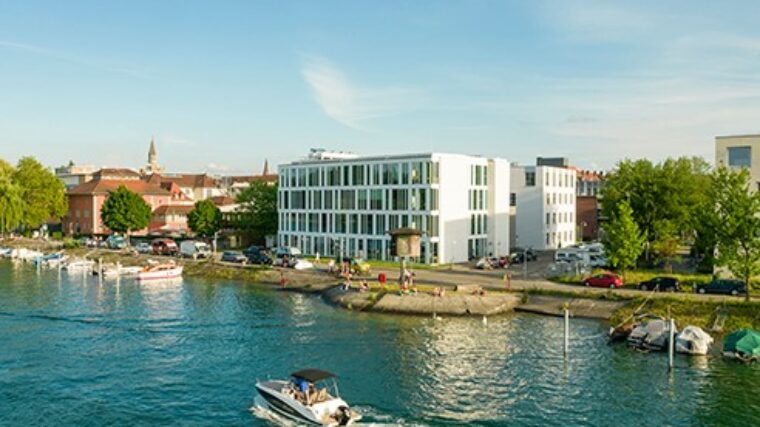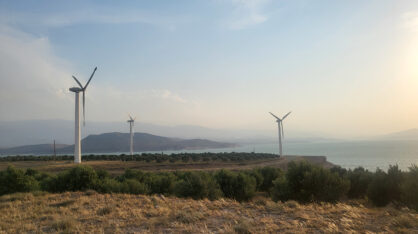HTWG Konstanz – University of Applied Sciences campus on the banks of the Rhine River, (Hochschule Konstanz, 2023)
The increasing demand for education for sustainable development in engineering studies is creating the need to have a curriculum that provides engineering competence for the students and also improves the ability to work in different cultures and countries to overcome challenges and so to cooperate in solving shared global problems.
In addition, international cooperation between universities of applied sciences can increase the competence of the staff in both universities and also create the possibility of global educational programs. The internationalization of educational programs in the universities of applied sciences can bring economic benefits to the countries and also promote cultural understanding, and lead to improved decision-making on global issues (Brito et al. 2018).
The objective of the visit to Konstanz was to promote teaching, research cooperation, student exchange possibilities and double degree programs between Vaasa University of Applied Sciences and Konstanz University of Applied Science (HTWG). Currently, there is low student and teacher mobility between the two universities despite similarities in the curriculum of both institutions. HTWG is located in the city of Konstanz near the Lake of Constance surrounded by Austria, and Switzerland. The attractive natural surroundings make it an ideal place to study and enjoy recreational activities. The article is presented as follows: the first section presents some of the highlights of our visit, the second section presents an overview of the programs at HTWG and the potential for cooperation in internationalization and education for sustainable development, and the conclusions are presented in the final section.
The highlight of our visit to HTWG
The key activities of our visit included a meeting at the international office, a campus tour and a visit to the student laboratory. In addition, discussions with Prof. Matthias Werner on possible cooperation in student exchange and the global project management programme were explored. We visited the laboratories of Electrical Engineering and Materials Engineering. Our guide was Prof. Dr.-Ing—Gunter Voigt, who has been a professor at HTWG for about thirty years. Prof. Voigt stressed the importance of practical experimentation and laboratory work in teaching at the University of Applied Sciences. Prof. Voigt and his colleagues emphasized the importance of laboratory work, since it is for students to simulate failure modes, for example in the electricity supply chain, that are rare and usually avoided by “real world” devices in operation. This creates a genuine learning experience for the student, as they learn not only where the faults come from, but also their risks and the necessary corrective measures. Prof. Voigt and his laboratory engineer demonstrated high-voltage discharge, in their high-voltage laboratory. Figure 2 below shows HTWG’s high-voltage laboratory on the left, and the high-voltage surface discharge seen on the surface of the glass plate on the right.

Surface discharges occur in situations where there is a sufficiently strong electric field between the interfaces of two insulations. HTWG’s demonstration saw the “Slip Discharge”, which is a powerful type of surface discharge. Discharges usually occur at the interfaces of insulators, which can be either between liquid and solid insulation or between air and solid insulation. The ignition voltage of the surface discharge depends on the thickness of the solid insulation and the properties of the insulating material (glass plate in the case of HTWG), which in turn affects the strength of the electric field (Rokka, 2022).
HTWG’s campus also has its own floating lab, which is a modified boat entirely done as a student project. This fibreglass boat, modified as a laboratory, is capable of utilising several renewable energy sources and is also used to test autonomous steering. See more about the floating lab in this YouTube video “Autonomes Schiff: Anlegemanöver Forschungsprojekt” (HTWG Boat Lab, 2021). A key highlight of the visit was meeting two VAMK students from the business department studying at HTWG (see Figure 3).

Internationalization and education for sustainable development
The following programmes are offered in at the bachelor and master level (see Table 1) which are potential areas of cooperation between VAMK and HTWG in the fields of business, design and technology. Most of the engineering programmes have strong links to business and management to encourage both staff and students to think outside the box of their academic and technical, and to work in an interdisciplinary and transdisciplinary way to ensure the development of new ideas. This model of interdisciplinary and transdisciplinary enables students to develop critical thinking and systems thinking which are critical for education for sustainable development (Sprain and Timpson, 2012; Lozano et al., 2017; Menon and Suresh, 2022).
| Bachelor | Master |
| Environmental Engineering and Resources Management | Environmental Engineering |
| Electrical Engineering and Information Technology | International Project Engineering |
| Electrical Engineering and Management | Business Information technology and Management |
| International Engineering and Management | Industrial Engineering and Management |
| Mechanical Engineering | |
| Mechanical Engineering and Management |
| Bachelor | Masters |
| Asian Management Studies | Business Management |
| Business Administration | International Management Asia-Europe |
| Business Communication, Management and Tourism | Legal Management |
The goal of internationalization for higher education institutions such as HTWG-Konstanz and VAMK should be to benefit the wider community, at both institutes, through international or intercultural education, research, service and student engagement (Brandenburg et al., 2019). The growing demand for education for sustainable development implies the need for more international programmes that promote the mobility of teachers and students. This approach creates innovative ways to develop curricula with important topics to fulfil the new requirement that meets the challenges of global trends and sustainable development. This can lead to improvements in building intercultural skills, developing knowledge of languages, and cultural prejudice management which are some of the essential skills required in education for sustainable development and to adapt to any cultural environment (Daneva et al. 2017). The role of higher education institutions in the internationalization and promotion of education for sustainable development is presented in Figure 2. Education for sustainable development provides students with skills to address the interdependent global challenges such as climate change and sustainable use of resources. International cooperation between universities of applied sciences can create learning hubs where students can exchange ideas and knowledge from different national and cultural perspectives to address current and future global challenges.

Conclusion
This paper presents our experiences and observations from our visit to HTWG and the ideas on how international exchange programs can contribute to education for sustainable development. The goal of sustainable development requires cooperation and collaboration between different skills, different cultures, international perspectives, and testing realities in different institutional and cultural environments. Promoting education for sustainable development means interactions among students and teachers in an international and global environment. One way to achieve this is to encourage student and teacher mobility among international partners and to participate in international projects. Curricula in engineering education should be developed in a way that encourages students to participate in international programs abroad or international projects. This would assist students to develop interpersonal and cultural competences required to meet the challenges in a complex global environment. In addition, teacher exchange and mobility would provide opportunities to collaborate in teaching and research projects at the EU level. This can provide the basis for developing innovative curricula that meets the challenges of achieving sustainable development goals. VAMK and HWGT have a lot of similarities, and increasing mobility programmes between the institutes would contribute to preparing our students for the challenges of the future.




